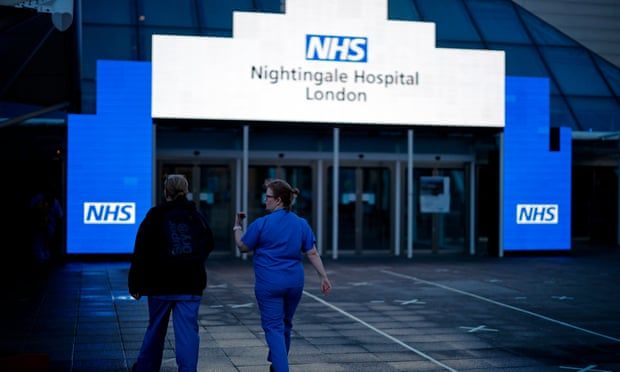If the strategy is not totally safe, reducing self-isolation to five days for positive COVID cases could increase the infection risk for vulnerable patients in hospital, according to a senior NHS leader.
People who test positive for COVID in England can reduce their self-isolation term from 10 to seven days from December 22 if they have a negative lateral flow test on day six and day seven and no high temperature. The 10-day norm has been followed in Scotland, Wales, and Northern Ireland.
Also read: COVID by omicron not ‘same disease’ we saw last year: Oxford scientist
However, there has been mounting pressure on the government to explore reducing self-isolation to five days, with some experts hesitantly supporting the concept. It has also gained traction in the hospitality industry, although scientists are still tasked with determining the move’s safety.
Chris Hopson, the chief executive of NHS Providers, has now chimed in on the discussion, claiming that the option is far from straightforward – even if it could assist the NHS deal with employee absences.
“COVID-19 continues to present policy decisions that necessitate challenging trade-offs between opposing agendas. Another of these is reducing COVID isolation from seven to five days,” he stated on Twitter.
Also read: UK, US record huge surge in daily COVID-19 cases as omicron spreads
Hopson mentioned excessive employee absenteeism owing to self-isolation across the economy, including in the health service, in a series of tweets.
“If staff absence rates and care quality/patient safety risk rise, pressure for a change to the isolation period will, inevitably, rise as well,” he said.
A transition to a shorter self-isolation time, on the other hand, could be problematic if it increases the incidence of hospital-acquired COVID infections, according to Hopson. And if persons remain infected after five days of self-isolation, community infection rates could climb, which is a concern given omicron’s unknown impact on elderly populations.
Another concern is that the availability of lateral flow and PCR tests has been disrupted.
Also read: Arsenal boss Mikel Arteta COVID positive for 2nd time, to miss Man City game
“A policy based on people needing negative PCR or lateral flow test results to exit isolation requires rapid, reliable and widespread access to those tests. This is not, currently, consistently the case,” he wrote.
Hopson went on to say that there is a lot of discussion in the scientific community over whether or not patients with omicron are contagious beyond five days, and to what extent.
Leading leaders in the hospitality business, whose holiday sales have dropped by as much as 60%, suggested a shorter isolation period could relieve some of the strain on the beleaguered industry.
Also read: Mail prints front-page statement as Meghan Markle wins copyright court battle
Phil Urban, the chief executive of Mitchells & Butlers, the 1,700-strong pub and restaurant firm that owns the Harvester and O’Neill’s brands, emphasised that the length of the COVID isolation period will be determined by the government’s scientific advisers.
However, he believes that a shorter gap would benefit the sector. “If people are isolating who are fine otherwise, the shorter the time period, the better it is. That would certainly be helpful.”
A shortage of tests, according to the trade association UK Hospitality, has caused a double whammy for the business, with employees taking longer to return to work and customers staying away.
“We’re kind of agnostic [on five-day isolation] because it’s so far out of our sphere of expertise,” said the chief executive, Kate Nicholls.
Also read: Manchester United goalkeeper David De Gea reveals ‘every moment with Ralf Rangnick is intense’
“It’s welcome news that they’re looking at it but we’d only want that if it was safe. We do need to make sure that we have a continued ready supply of lateral flow tests,” she added.
The United States recently declared that anyone with COVID but no symptoms will be subjected to a five-day self-isolation period, with mask usage required for a further five days. Some experts, however, have criticised the proposal because in the United States, persons are not required to obtain negative COVID tests before departing from self-isolation.
According to Lawrence Young, a virologist and professor of molecular oncology at Warwick Medical School, the time it takes to become and remain infectious varies from person to person and by variant, with some evidence suggesting that infection and infection with omicron can take as little as two to three days.
Also read: Manchester United goalkeeper David De Gea reveals ‘every moment with Ralf Rangnick is intense’
“This infectious period can occur before the onset of symptoms and last for between two and three days after you become symptomatic,” he said.
Young went on to say that the present seven-day plus testing approach used in the UK is reasonable and allows for individual variation. But, he added, “Reducing the self-isolation period to five days without robust evidence is a concern and could only be introduced with the strict enforcement of lateral flow testing.”
A paper by scientists at the UK Health Security Agency, yet to be peer reviewed, suggests that relying on two negative lateral flow tests alone would risk a high proportion of people being released while still infectious due to false negatives, suggesting a mandatory isolation period is also necessary.
Also read: Post Windsor Castle break-in, crossbow laws to be reviewed in UK
“A mandatory isolation period of longer than seven days will not provide much more safety but lowering this mandatory isolation point will increase the percent of ‘false releases’ dramatically,” said the team.
A government spokesperson said, “There are no further changes to the isolation period planned at this time, but we keep all rules under review based on the latest health data.”







